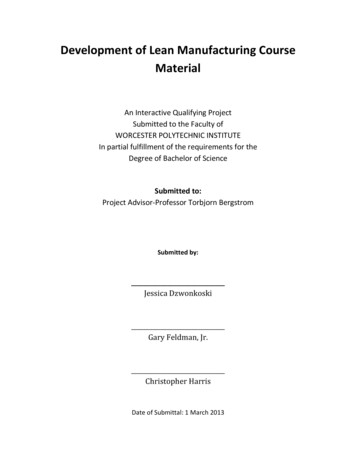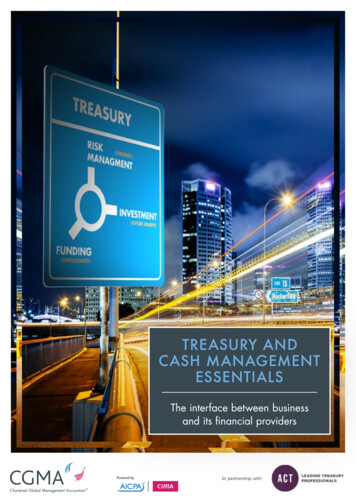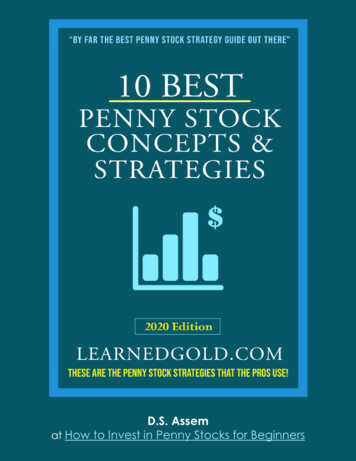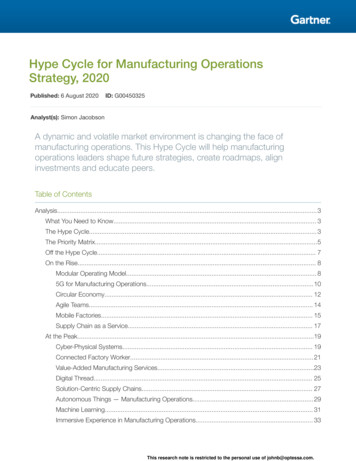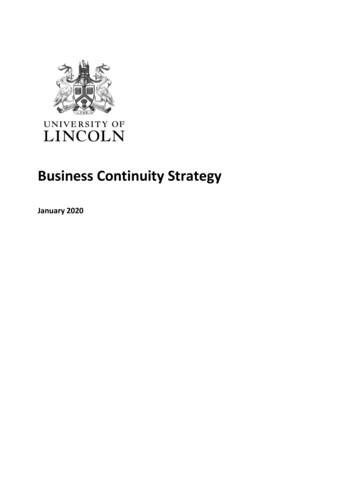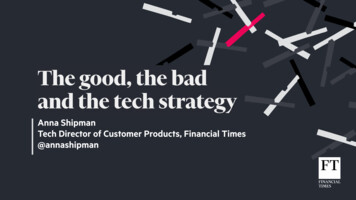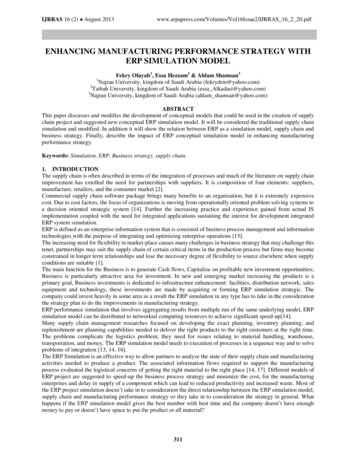
Transcription
IJRRAS 16 (2) August 2013www.arpapress.com/Volumes/Vol16Issue2/IJRRAS 16 2 20.pdfENHANCING MANUFACTURING PERFORMANCE STRATEGY WITHERP SIMULATION MODELFekry Olayah1, Essa Hezzam2 & Ahlam Shamsan3Najran University, kingdom of Saudi Arabia (fekrydrm@yahoo.com)2Taibah University, kingdom of Saudi Arabia (essa Alkadasi@yahoo.com)3Najran University, kingdom of Saudi Arabia (ahlam shamsan@yahoo.com)1ABSTRACTThis paper discusses and modifies the development of conceptual models that could be used in the creation of supplychain project and suggested new conceptual ERP simulation model. It will be considered the traditional supply chainsimulation and modified. In addition it will show the relation between ERP as a simulation model, supply chain andbusiness strategy. Finally, describe the impact of ERP conceptual simulation model in enhancing manufacturingperformance strategy.Keywords: Simulation, ERP, Business strategy, supply chain.1. INTRODUCTIONThe supply chain is often described in terms of the integration of processes and much of the literature on supply chainimprovement has extolled the need for partnerships with suppliers. It is composition of four elements: suppliers,manufacture, retailers, and the consumer market [2].Commercial supply chain software package brings many benefits to an organization, but it is extremely expensivecost. Due to cost factors, the focus of organizations is moving from operationally oriented problem solving systems toa decision oriented strategic system [14]. Further the increasing practice and experience gained from actual ISimplementation coupled with the need for integrated applications sustaining the interest for development integratedERP system simulation.ERP is defined as an enterprise information system that is consisted of business process management and informationtechnologies with the purpose of integrating and optimizing enterprise operations [15].The increasing need for flexibility in market-place causes many challenges in business strategy that may challenge thistenet, partnerships may suit the supply chain of certain critical items in the production process but firms may becomeconstrained in longer term relationships and lose the necessary degree of flexibility to source elsewhere when supplyconditions are suitable [1].The main function for the Business is to generate Cash flows, Capitalize on profitable new investment opportunities;Business is particularly attractive area for investment. In new and emerging market increasing the products is aprimary goal, Business investments is dedicated to infrastructure enhancement: facilities, distribution network, salesequipment and technology, these investments are made by acquiring or forming ERP simulation strategic. Thecompany could invest heavily in some area as a result the ERP simulation in any type has to take in the considerationthe strategy plan to do the improvements in manufacturing strategy.ERP performance simulation that involves aggregating results from multiple run of the same underlying model, ERPsimulation model can be distributed to networked computing resources to achieve significant speed-up[14].Many supply chain management researches focused on developing the exact planning, inventory planning, andreplenishment are planning capabilities needed to deliver the right products to the right customers at the right time.The problems complicate the logistics problem; they need for issues relating to material handling, warehouse,transportation, and money. The ERP simulation model needs to execution of processes in a sequence way and to solveproblems of integration [13, 14, 16].The ERP Simulation is an effective way to allow partners to analyze the state of their supply chain and manufacturingactivities needed to produce a product. The associated information flows required to support the manufacturingprocess evaluated the logistical concerns of getting the right material to the right place [14, 17]. Different models ofERP project are suggested to speed-up the business process strategy and minimize the cost, for the manufacturingenterprises and delay in supply of a component which can lead to reduced productivity and increased waste. Most ofthe ERP project simulation doesn’t take in to consideration the direct relationship between the ERP simulation model,supply chain and manufacturing performance strategy or they take in to consideration the strategy in general. Whathappens if the ERP simulation model gives the best number with best time and the company doesn’t have enoughmoney to pay or doesn’t have space to put the product or all material?311
IJRRAS 16 (2) August 2013Olayah & al. Enhancing Manufacturing Performance Strategy2. RELATED WORKDay-to-day, ERP simulation is being accepted and becoming a part of the day-to-day of analysis, looked upon as atechnique to verify solutions and providing early solutions to problems encountered in the most diverse industrialsegments [ 14,15],Advantages of using ERP simulation in supply chain and business strategy as a whole according to [4, 5, 6, 7]represent the capability to simulate and present the reality of anything in a clear and easy way. At the same time thereare disadvantages. In [8] provided an overview of a successful integration between ERP simulation model (VinLogic)and a vehicle shipment information system (VinVision). This integration allows the simulation model to be initializedwith vehicle inventory in the network. Model initialization enables the model to be used not just for measuringperformance over the length of the run, such as average transit time, but also to obtain a snapshot of the system as sometime in the near future. Improvements in the timeliness of event reporting to VinVision will have a significant impacton the ability to make accurate projections. Development of an ERP simulation model for evaluating the businessprocesses and inventory control parameters of a logistics and distribution supply chain will provide solutions toproblems encountered in the most divers’ industrial segments [3, 9]. A generic simulation tool, rather than an ERPsimulator, was developed for meeting customized needs of the effort.In [10], proposes a hybrid approach which is a specific problem solving procedure combining analytic and simulationmethods to solve production-distribution problems in supply chain. The machine capacity and distribution capacityconstraints in the analytic model are considered as stochastic factors and are adjusted by the proposed specific processaccording to the results from an independently developed ERP simulation model which includes generalproduction-distribution characteristics). In [11] suggests new ERP simulation software: Easy-ERP, a Java-based toolthat simplifies the ERP simulation. In its current state of development, Easy-ERP is a modeling tool for assessing thepros and cons of new facility locations, resource allocations and different combinations of policies. It can be used inthe modeling of small projects such as single inventory units to large-scale projects such as world-wide supply chains.This paper introduces Easy-ERP by an examination of its current software module architecture, modeling elements,basic features and simulation processes [14, 15].3. PROPOSED CONCEPTUAL MODELAccording to the related work, simulation approaches suggested by different authors, we have seen no relationbetween the supply chain simulation and manufacturing performance strategy; we suggested a modification to one ofthe simulation suggested by [9] and looked at the difference. It is necessarily to explain in brief the model suggested in[9], the supply chain Proposed in [12], considers four stages: suppliers, manufacturers, retailers, and the consumermarket. The structure for the conceptual model proposed for this type of chain is composed of hierarchical levels. Thefirst level, the most general, is composed by the four elements and by their integration made by orders andmaterial/products flows. At the second hierarchical level, one performs the intermediate modeling of each SCmember. Detailed modeling of specific functions (intra-company) is designed at the third levels. The first version forthe proposed models presents a single way to model suppliers, manufacturers, retailers and customers. Initially, thefourth level was implemented detailing even more of each supplier, retailer and manufacturer, however, it was laterrealized that this was redundant for the proposed model. The generic structure with three hierarchical levels has beendeveloped for the CS considered, and is shown at Figure 1. This is the structure proposed in [2, 14, 19].312
IJRRAS 16 (2) August 2013Olayah & al. Enhancing Manufacturing Performance StrategyFigure 1. SC General Modeling Structure [2]When an inventory level gets lower than a minimum specified (safety inventory level), an order for the material(component or product) purchase (or manufacturing) is placed. The optimum order size (quantity) and the safetyinventory levels are given by the decision-maker. At a production facility, two types of orders exist: purchase orders,for the purchasing of components from suppliers, and production orders, for the manufacturing of products (differentproduct types are considered, and each product is made of different combination of components). Regarding theconsumer market, each retailer has demand patterns. There are different demand behaviors [2]. In [3] suggest structurein the simulation software ARENA, a set of global variables needs to be defined, all these variables arebi-dimensional, with their respective sizes represented by the variables in between brackets. In this table and on theArena models, some of the notations used were:Figure 2.Notations and Variables for the SC Simulation [3]313
IJRRAS 16 (2) August 2013Olayah & al. Enhancing Manufacturing Performance StrategyEach company, whether a start-up or a mature company should develop some form of a business plan. The plan shouldexplain the company's objectives over a three to five year period and should quantify the financial resources andexpenditures of the company. Using its known plans and statistics for its industry, the company should challenge itscapitalization and determine appropriate debt and equity funding levels. Using this plan, the company shoulddetermine its needs for outside funds over the three to five year period and also determine the finance that is availableand applicable to the company. The company then determines the sources available for the appropriate financing andbegins making contact with the appropriate sources and other professionals who have contacts with these sources.Particularly in the start-up companies, cost control measures should be instituted from the beginning and all effortsshould be made to control cash expenditures appropriately match you’re financing needs with sources for that type offinancing. Another critical issue is timing. It is virtually impossible to obtain financing of any type within thirty orsixty days. Those who are successful at obtaining financing know who is doing their type of financing and plan far inadvance to begin educating those financing sources as to their company and their industry. Those who succeed have aformal business plan that well demonstrates their managerial, abilities and the viability and marketability of theirproducts. Implemented the ERP simulation at a business will be part of the strategy and affect by and from businessstrategy Figure 3.Business StrategyERP SimulationSCFigure 3.ERP simulation at a manufacturing will be part of the strategy and affect by and from strategyFour elements compose the first hierarchical level in the proposed ERP system simulation conceptual model:suppliers, manufacturers, retailers, and the consumer market. The integration is simplified by information and material(components or products) flows. This is illustrated at Figure 4. The letter in circles is used to detail the models in thefollowing descriptions.Figure 4. First levels in the proposed conceptual model hierarchyThe different between figure [3] and figure [4] that strategy in figure [4] has checked after each activity in the ERPsimulation to see whether the result for the simulation accepted by strategy if not, the strategy has to have action tomodify the result for the simulation according to the strategy action and not to best number of the simulation.314
IJRRAS 16 (2) August 2013Olayah & al. Enhancing Manufacturing Performance StrategyFigure 5. Conceptual Model [2].This activity has to do it each time within four elements, Consumer, Retailers, Manufacture, and Suppliers. Each oneof these members will assume that the demand for the next time period will be equal to the last demand. In figure 5,starting studying the consumer marketing (A) and compared with strategy plan that (A) to (A1) TO (A). If the strategyplan agrees it goes to (B) if not changed the simulation input according to the strategy and input to (B), from theRetailers output (C) to (C1) To (C) if the strategy plan agrees it goes (D) if not changed the simulation input and inputto (D), take output (E) To (E1) again To (E) if the strategy plan agrees it goes and input to (F) if not changed thesimulation input (F), from the Suppliers take output (G) To (G1) back to (G) if the strategy plan agrees to input to (F)if not changed the simulation input (F) ,take the output (G) To (G1) back to (G) if the strategy plan agrees with output(G) goes to (H) if not changed the simulation input according to the strategy and further to input (H) , from this pointthe simulation could work.315
IJRRAS 16 (2) August 2013Olayah & al. Enhancing Manufacturing Performance StrategyAA1NoIf the consumermarket agree withstrategy planeChange thesimulationYeas(B) AndinputRetailersinputABFigure 6.Proposed Modified Conceptual Model.4. CONCLUSIONSClearly, there is a strong relationship between the ERP system simulation and manufacturing performance strategy.The ERP simulation model needs to check with manufacturing strategy plan to have a correct suggestion fromsimulation. The business has limitations with, products, capital, and warehouse. This research is theoretical andneeds further work to test and improve the proposed modified ERP conceptual simulation model before going topractice.5. REFERENCES[1] A.Smart and A. Harrison. Reverse Auctions as a Support Mechanism in Flexible Supply Chains InternationalJournal of Logistics Research and Applications, Volume 5, Issue 3 , 2002 , pp 275 – 284.[2] Vieira, G. E. Ideas for modeling and simulation of supply chains with arena, Proceedings of the Winter SimulationConference; U.S.A., 2007.[3]M. E. Kuhl, N. M. Steiger, F. B. Armstrong,. A. Joines,E. Vieira, and César Júnior, A conceptual model for thecreation of supply chain simulation models Proceedings of the Winter Simulation Conferenec,2005.[4] Wallace, T. F. (1990). ERP: Making It Happen: The Implementers Guide to Success with Manufacturing ResourcePlanning. New York: Wiley.[5] Pedgen, D. C.; Shannon R. E.; & Sadowski, R.P. Introduction of Simulation using Siman. 2 Ed.U.S.A.,McGraw-Hill, 1995.[6] Chang, Y.; Makatsoris, H. Supply chain modeling using simulation. University of Cambridge; Institute forManufacturing, I.J. of Simulation, Vol.2, No.1, 2001, pp. 24-30.[7] Banks, J., J.S. Carson II, B.L. Nelson, and D.M. Nicol. Discrete-Event System Simulation, Prentice Hall, 2001.[8] Malay A. Dalal, Henry Bell, Mike Denzien, and Michael P. Keller: Supply chain management simulation:initializing a distribution supply chain simulation with live data. Winter Simulation Conference 2003, pp1621-1626.316
IJRRAS 16 (2) August 2013Olayah & al. Enhancing Manufacturing Performance Strategy[9] Jain, S.; Workman, R.; Collins, L.M.; Ervin, E. Development of a high-level supply chain simulation model.Proceedings of the 2001 Winter Simulation Conference;U.S.A., 2001, pp. 1129-1137.[10] Lee and Kim, Optimal production distribution planning in supply chain management, Proceedings of the WinterSimulation Conference, 2000.[11] Richard J. Linn, Development of distributed simulation model for the transporter entity in supply chain process,Proceedings of the, Winter Simulation Conference, 2002.[12] B. A. Peters, J. S. Smith, D. J. Medeiros, and M. W. Rohrer, eds. Sanjay Jain, W. Workman Development of ahigh-level supply chain simulation model, Proceedings of the Winter Simulation Conference, 2001.[13] Guixiu Qiao, Frank Riddick: Modeling Information for Manufacturing-Oriented Supply-Chain Simulations.Winter Simulation Conference, 2008.[14] Palaniswany, R & Frank, T. Enhancing Manafacturing performance with ERP system. Information SystemManagement, Vol 17, Issue 3, 2000.[15] Kim, J. Activity-based Framework for cost savings through the Implementation of an ERP system. InternationalJournal of Production Research, Vol 47, Issue 7, 2009, pp 1913-1929.[16] Duplaga, E.A& Astani, M. Implementing ERP in Manafacturing. Information System Management, Vol 20,Issue 3, 2003,pp 68-75.[17] Madapusi, A & Souza,D,D. Aligning ERP system with International Strategies. Information System ManagementVol 22, Issue 1, 2005, pp7-17.[18] Vieira, G. E. Ideas for modeling and simulation of ERP with arena, Proceedings of the Winter SimulationConference; U.S.A., 2007.[19] Wallace, T. F. (1990). ERP: Making It Happen: The Implementers Guide to Success with ManufacturingResource Planning. New York: Wiley.317
Implemented the ERP simulation at a business will be part of the strategy and affect by and from business strategy Figure 3. Figure 3.ERP simulation at a manufacturing will be part of the strategy and affect by and from strategy Four elements compose the first hierarchical level in the proposed ERP system simulation conceptual model:


